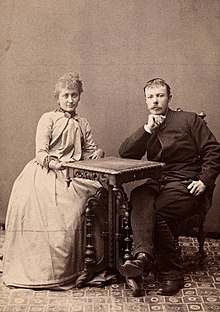Hulda Garborg

Hulda Garborg (born on 22. February 1862 in rod as Karen Hulda Bergersen , died on 5. November 1934 in Asker ) was a Norwegian writer and theater director . She was Arne Garborg's wife .
Private life
Her parents were the lawyer Christian Frederik Bergersen (1829–1873) and his wife Marie Petrine Olsen (1835–1888). Her two older sisters were named Martha and Sophie. After her parents divorced in 1864, she moved with her mother to Hamar , and in 1874 to Kristiania . When she was seventeen, she started working in a business to support the family.

Having become aware of her national cultural scene through a teacher, she began to be interested in art and politics and made relevant contacts in the capital. On December 3, 1887, she married the poet Arne Garborg, who was already celebrated in Europe, and moved with him to Tynset , to a small farmhouse on Lake Savalen . In 1888 she gave birth to her son Arne Garborg. The couple did not live in isolation, but traveled frequently, not only to Kristiania, but also to Paris , Berlin , Dießen and Fürstenfeldbruck . In 1896 the Garborgs left Tynset and first moved to Stokke , and one year later to Hvalstad near Kristiania. There she was also successful in local politics and represented the liberal Venstre party in her Asker district .
After her death in 1934, she was buried with her husband, who had died ten years earlier, at his summer home in Time .
Create
Garborg's literary work was largely parallel to that of her husband, but must be viewed independently. Like her husband Arne, she was interested in the Norwegian national identity, for example the bunad , folk dances, traditional cuisine and family, but also theater and women's rights . She began by publishing articles on Norwegian cuisine , which were later collected. After that she concentrated on the theater and founded Det norske spellaget , which is now known as Det Norske Teatret . She eventually wrote novels and non-fiction, published political writings in magazines and magazines, including on women's rights, and gave speeches. So she wrote a protest against Otto Weininger's main misogynistic work Gender and Character .
Pieces
- Mødre (1895, drama mothers )
- Rationelt Fjøsstell (1896, comedy)
- Hos Lindelands (1899, comedy)
- Noahs Ark (1899, farce)
- Sovande sorg (1900, drama)
- Liti Kersti (1903, Klein-Kersti )
- Edderkoppen (1904, anonymous drama)
- April (Vaar) (1905, drama)
- Kongens cone. Interior from Ludvig XIV's hoff (1906, drama)
- Sigmund Bresteson (1908, drama Sigmund Bresteson )
- Under Bodhitræet (1911, drama)
- Tyrihans (1915, chant Tyrihans )
- Den store Freden (1919, drama The Great Peace )
Fiction
- Et frit forhold (1892, anonymously published marriage novel A free relationship )
- Mann av Guds Naade (1908, novel)
- Eli (1912, novel)
- Mot Solen (1915, novel Zur Sonne )
- Gaaden. Efter Præstedatteren Else Marie Lindes Optegnelser (1916, novel)
- Mens dansen gaar (1920, novel While you dance )
- I huldreskog (1922, novel Im Hulderwald )
- Naar heggen blomstrer (1923, novel When the hedges are in bloom )
- Grågubben (1925, novel The Gray Old Man )
- Trollheimen (1927, novel)
- Helenes historie (1929, novel)
- Hildring (1931, novel)
- Kornmoe (1930, collection of poems)
- Symra (1934, collection of poems)

Non-fiction and political writings
- Fra Kolbotnen og andetsteds (1903, autobiographical diary Von Kolbotten and elsewhere )
- Heimestell (1899, collected articles on Norwegian cuisine)
- Norske folkevisor (1903, song collection)
- Song-Dansen i Nord-Landi (1903, song collection Tanzlieder im Nordland )
- Norsk klædebunad (1903, extended 1917, about Bunad costumes)
- Kvinden skabt af Manden (1904, women's rights book The woman created by the man )
- Fru Evas Dagbog (1905, women's rights book Frau Evas Diary )
- Norske dansevisur (1913)
- National fare (1925)
- Barndomsminne (1935, childhood memories)
- Six-volume edition of her husband's diaries, after 1924
- Selected diaries between 1903 and 1914, posthumously 1962
Honors
In 1932, Hulda Garborg was made a first class knight of the Order of Saint Olav .
Individual evidence
- ↑ a b Atle Døssland: Hulda Garborg , In: Norsk biografisk leksikon , Volume 3. Kunnskapsforlaget, Oslo 2001.
- ↑ a b Antonius Lux (ed.): Great women of world history. A thousand biographies in words and pictures . Sebastian Lux Verlag , Munich 1963, p. 180
| personal data | |
|---|---|
| SURNAME | Garborg, Hulda |
| ALTERNATIVE NAMES | Bergersen, Karen Hulda (maiden name) |
| BRIEF DESCRIPTION | Norwegian writer and theater director |
| DATE OF BIRTH | February 22, 1862 |
| PLACE OF BIRTH | pole |
| DATE OF DEATH | November 5, 1934 |
| Place of death | Asker |
